-
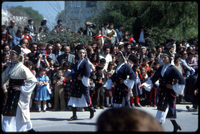
This image shows a parade on a paved street. The performers, in traditional Greek dress, are dancing in the middle of the street as many onlookers of both adults and children watch from the sides. This parade took place in Heraklion, a city in Crete.
-
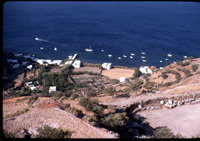
This image shows the island of Melos which is both an archeological site and a currently inhabited island in the Aegean sea. One can see the island sloping towards the water with modern houses, vineyards, and a harbor with boats on the lower land and the excavation sites of what appears to be columns on the higher land.
-
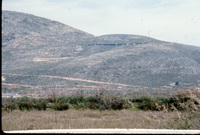
This image shows the landscape of New Pleuron, which is an ancient city at the bottom of Mount Aracynthus.
-
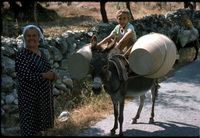
This image shows three figures, 2 children riding on donkeys laden with loads of supplies and an older woman leading one of the donkeys. The path they are on appears to be paved with low stone walls on one side and overgrowth of plants in the vicinity of Eleutherna or Kommos. The people seem to be caught in a moment of daily life where transporting goods/supplies is a routine occurrence.
-

This image looks down upon the ruins of an ancient site (Gournia) nestled in what appears to be a valley surrounded by mountains, as there is a high vantage point of the photographer.
-
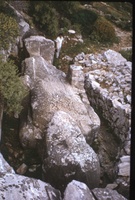
This image shows a unique angle of the Naxos Kouros, laying horizontally in a quarry on Naxos. The Kouros is fundamentally geometrical and was most likely not completed by the artisan that sculpted it, as evidenced by the extremely basic and simplistic indications of body parts.
-
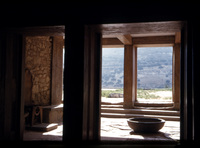
This image of the Throne Room at the ancient site of Knossos shows an interior space with stone walls, and floors, there are also beams holding up the roof and a large basin in the middle of the room. The space is open to the outside hilly terrain and also has benches along the walls and a throne.
-
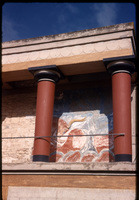
This image shows the Bull Fresco in the North Bastion of the ancient site of Knossos. This Fresco works in primary colors of red blue and yellow and depicts a bull with its horns down heading towards a tree. The horns of the bull especially stick out in the Fresco in a technique known as relief fresco. The Fresco itself is reconstructed and housed under a reconstructed porch with columns holding it up.
-
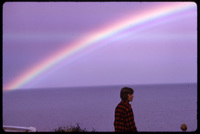
This image shows a young man in a red flannel (contemporary dress) looking over his shoulder and another figure in front of him both of which are standing in front of the ocean in Agios Nikolaos, a coastal town on the island of Crete. Above them stretches a rainbow, which gives the photograph a purple tint.
-
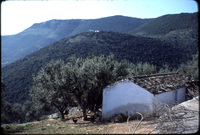
View of the mountains and settlements in Ithaca. There is one structure in the foreground, off center to the right, which has chickens. There is also a structure on the horizon which seems to be a house.
-
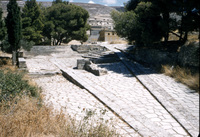
This is a view of the Royal Road leading to the Theatral Area at Knossos. The natural elevation is apparent through the leveling and building of pathways through the terrain. The Theatral Area lies at the end of the Royal Road (as seen in sackett_172) and shows the eastern flight of 18 stairs.
-
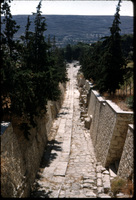
This is a view of a road which has a downward slope and looks out at hills in the distance. On each side of the road is distinguished sets of properties and stone walls. The Royal road leads to the Theatral Area of Knossos.
-
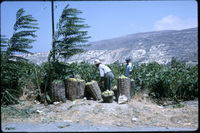
View of two men picking fruits along the side of a possible road, and collecting them in large wooden baskets. This image was taken from a taverna at Knossos.
-
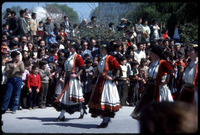
Women dressed in ceremonial dress walking in possibly a parade (Heraklion Independence Day, based on the date of 3/25). Women, men, and children watch the parade.
-
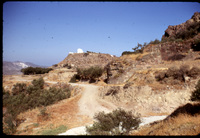
View of a town on Melos, showing roads and trails which wind through the mountainous area. The pictures shows what also could be ruins or stone/brick walls.
-

This is a view of part of a wall at the archaeological site of Kommos, off center and largely out of frame. The ocean and mountains are visible in the background.
-
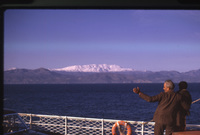
This is a view of Mt. Ida from a ferry in the Aegean Sea. Pictured are a car and some men on the same vessel.
-
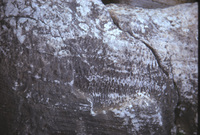
This is a view from one of the sides of the Kouros of Apollonas in a quarry at Naxos. The Kouros is of monumental size and is made of Naxian marble. The Kouros is around 11meters tall and is dated to the seventh to sixth century BCE.
-

View of snow covering the tops of Crete mountains, possibly at sunrise/sunset due to the low lighting.
-
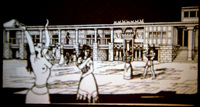
Depicted is the rectangular courtyard at the palace of Knossos. The artist uses size diminution among the four figures (pictured on a diagonal) to show receding space. Close attention is show to the garb of each figure, and the headpiece of the rearmost figure on the right suggests that we are witnessing a ceremony and/or ritual.
-
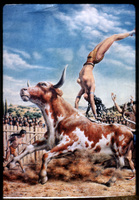
This is a modern interpretation (and likely a dramatization) of the Minoan ritual of bull jumping. Depiction by artist Rudolph Zallinger.
-
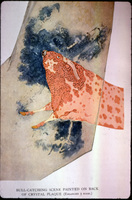
This is an image from the Palace of Minos, the excavation report on Knossos by Sir Arthur Evans. On the back of a crystal plaque a red bull has been rendered in the classic "flying gallop" style that was used in the Minoan period to ellucidate something in motion. The larger image that this was once a part of may have depicted a Minoan ritual of bull jumping. The bull is articulated as a single mass. Distinctive muscle bulges or deliniation of the neck area is not found.
-
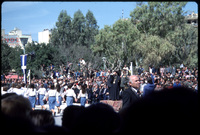
Photograph of Greeks celebrating their Independence day with a parade through the street. Men, women and children gather for the parade. Children are marching. A Greek Orthodox priest is visible in the crowd.
-
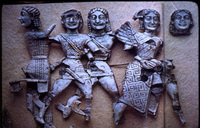
This image shows four bodies of garmented individuals. The leftmost individual is in profile view, while the two to the right are shown in composite perspective. Each figure has their own specifically patterned type of clothing. Their faces have slight notions of particularization that dignify one from another, but overall they are types.
-
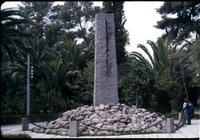
Memorial for the Swedish fighters that died in the Greek War for Independence that spanned from 1821 to 1829. The monument is a large pillar made of stone with greek words carved into the lower-third of it. The text reads "In memory of the Swedes who died in the fight for Greek freedom." A black streak that starts as a circle and falls in a line through the engraved letters then stops. At the base of the monolith is an accumulation of stones that pile on top of one other, obscuring the bottom of the monument from view.
























